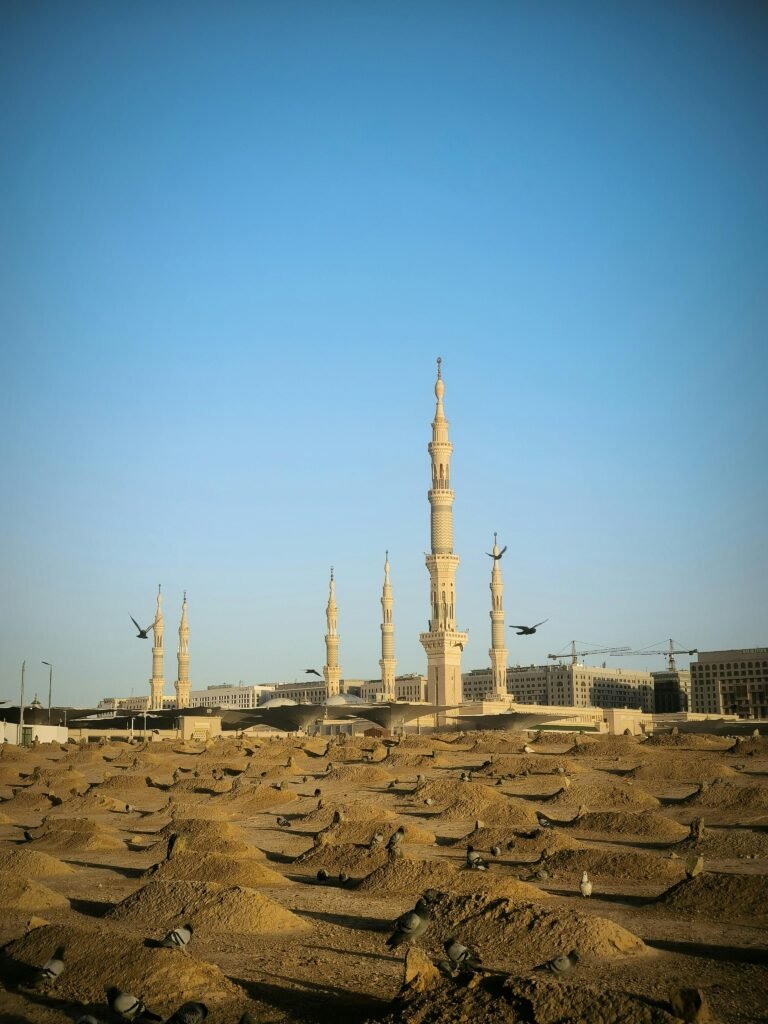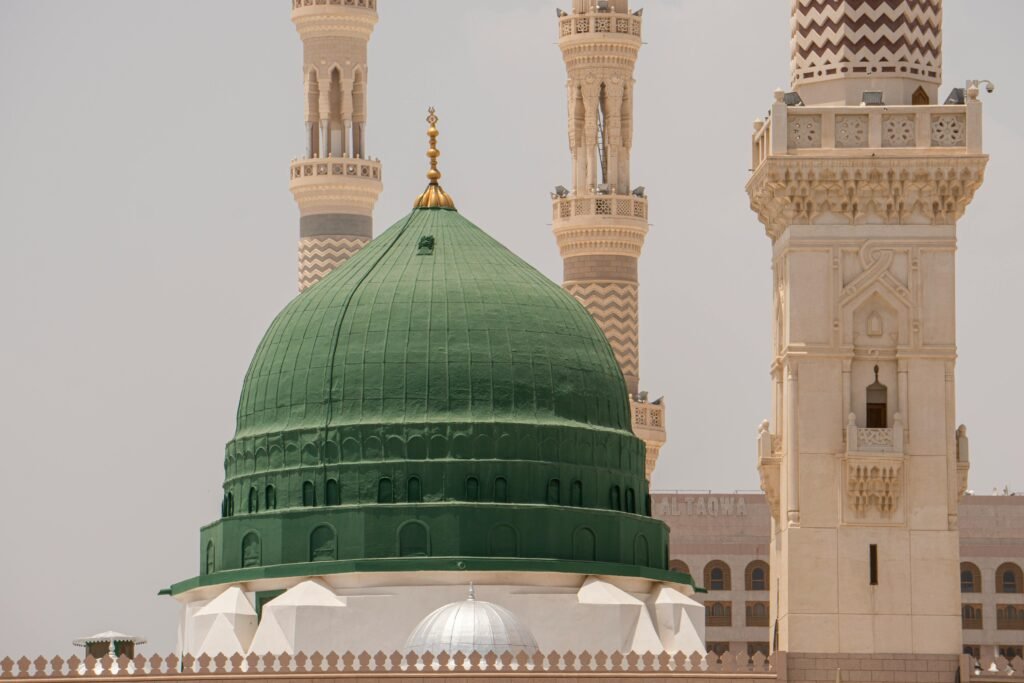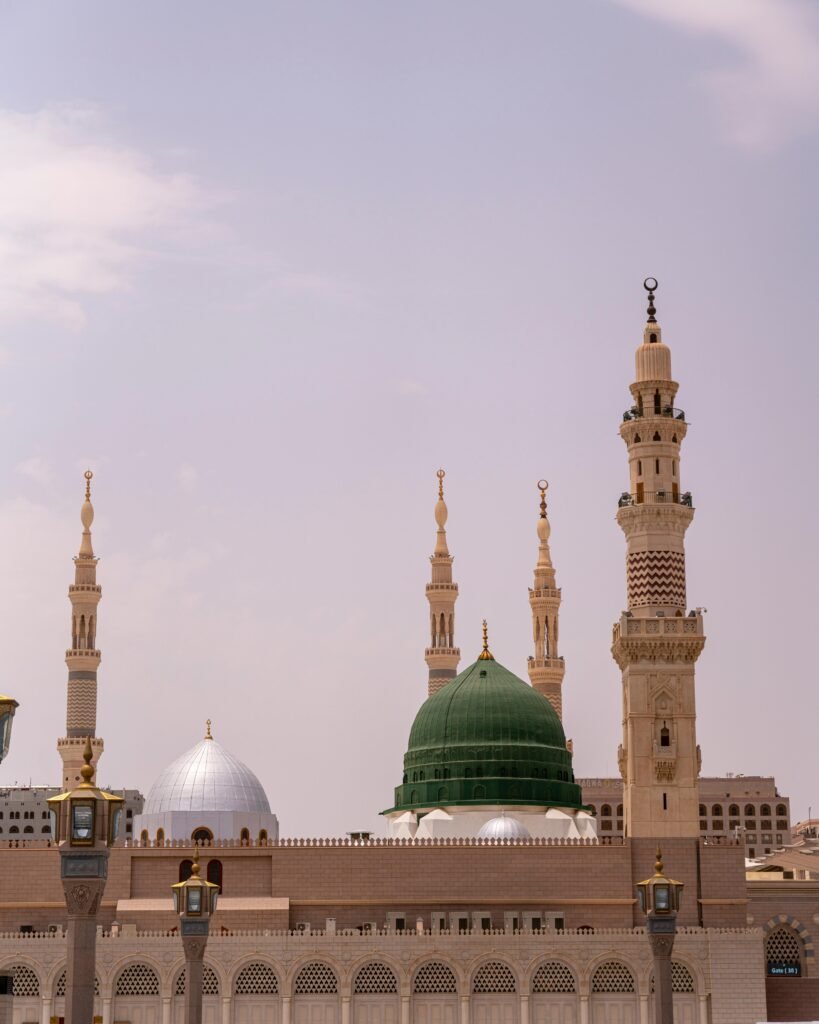Baqi’s original name is Baqi’ Al-Gharqad. The word “Gharqad” means thorny tree. This area was once covered with thorny trees, which were later cleared, but the original name of the place remained. It is the cemetery of Madinah. Another name for it is Qabta, which means protection. Since a graveyard is a place of protection for the deceased, it is called Qabta.
Why is Jannatul Baqi special?
Jannatul Baqi is special because most of the family members of the beloved Prophet Muhammad (peace be upon him), including his wives, daughters, sons, and other relatives, as well as thousands of companions, are buried there.
This cemetery is located to the east of Masjid-e-Nabawi. According to a narration by Imam Malik (may Allah have mercy on him), approximately 10,000 companions are buried in Jannatul Baqi, but no grave has a nameplate.
Among those buried in Jannatul Baqi are the Prophet’s daughter Fatimah (may Allah be pleased with her) and Ruqayyah (may Allah be pleased with her), his uncle Abbas (may Allah be pleased with him), his son Ibrahim (may Allah be pleased with him), his grandson Hasan (may Allah be pleased with him), Uthman bin Maz’un (may Allah be pleased with him), his foster mother Halimah Sa’diyah (may Allah be pleased with her), Ummul Mu’mineen Aisha (may Allah be pleased with her), the third Caliph Uthman (may Allah be pleased with him), the fourth Caliph Ali (may Allah be pleased with him), the companion Abdur Rahman bin Auf (may Allah be pleased with him), Sa’d bin Abi Waqqas (may Allah be pleased with him), and Abdullah bin Mas’ud (may Allah be pleased with him), among others.
Virtues of Baqi Cemetery
This cemetery has many virtues. It is narrated in Sahih Muslim from Aisha (may Allah be pleased with her): She said, “Shall I not narrate to you an incident about the Messenger of Allah (peace be upon him) on the night he stayed with me?” She continued, “He removed his cloak, took off his shoes, and lay down. After a while, he thought I had fallen asleep. Then, he quietly took his cloak, slowly put on his shoes, opened the door, and left. I covered myself, put on my clothes, and followed him. He went to the Baqi cemetery and stayed there for a long time. He raised his hands to Allah three times. Then he returned, and I also returned. He walked fast, and I walked fast. He came to the house, and I entered before him and lay down. When he entered the house, he asked, ‘O Aisha, why are you breathing heavily?’ Aisha replied, ‘Nothing.’ Then he said, ‘You will tell me, or the All-Knowing Allah will inform me.’ Aisha said, ‘O Messenger of Allah, may my parents be sacrificed for you.’ Then I told him what happened. He asked, ‘Was that shadow I saw you?’ I replied, ‘Yes.’ I felt a tremor in my heart that caused me pain. Then he said, ‘Did you think Allah and His Messenger would wrong you?’ Aisha said, ‘Whatever people conceal, Allah knows it.’ He replied, ‘Yes. When you saw me, Jibreel (peace be upon him) came to me and called me. He remained hidden from you, and I replied to him but did not inform you. Jibreel did not enter your room because you were not fully dressed. I thought you were asleep, so I did not wake you. I feared it might surprise you. Jibreel told me: (O Prophet.) Your Lord commands you to go to the Baqi cemetery and pray for the forgiveness of the deceased there.’ Aisha then asked, ‘O Messenger of Allah, how should I pray for them?’ He said, ‘You should say,
السَّلامُ عَلَيْكُمْ أَهْل الديار من المُؤْمِنِينَ وَالمُسلمين، ويرحم الله المستقدمين والمستأخزِينَ، وَإِنَّا إِنْ شَاءَ اللَّهُ بِكُمْ لَا حِقُونَ
Translation: Peace be upon you, O dwellers of the graves, believers, and Muslims. May Allah have mercy on those who have gone ahead of us and those who come later. Indeed, if Allah wills, we shall join you.’
It is narrated in Sahih Muslim from Aisha (may Allah be pleased with her): On the night the Prophet (peace be upon him) stayed with me, he would go to the Baqi cemetery at the end of the night and say, ‘O believers of the graves, tomorrow you will receive what you have been promised. Indeed, we will also join you if Allah wills. O Allah, forgive the inhabitants of Baqi Al-Garqad.’
It is narrated from Ibn Abbas (may Allah be pleased with him) that the Messenger of Allah (peace be upon him) passed by the cemetery of Madinah and turned his face toward their graves and prayed, ‘Peace be upon you, O inhabitants of the graves. May Allah forgive us and you. You have preceded us, and we will follow you.’ (Tirmidhi)
Umme Qais bint Muhsin narrated that the Messenger of Allah (peace be upon him) took her to the Baqi cemetery and asked, ‘Do you see this cemetery?’ I replied, ‘Yes.’ He said, ‘On the Day of Judgment, Allah will raise seventy thousand people from here with faces as bright as the full moon, who will enter Paradise without reckoning.’ The Baqi cemetery will illuminate the inhabitants of the heavens, just as the sun illuminates the inhabitants of the earth.
Az-Zubair narrated from Jabir (may Allah be pleased with him) that the Messenger of Allah (peace be upon him) said, ‘Allah will raise 100,000 people from this cemetery called Qabta, who will be as bright as the full moon and who did not seek or perform any superstitious healing.’
Location and Expansion
Baqi Al-Garqad cemetery is located in the eastern part of Madinah city, adjacent to the extended Masjid-e-Nabawi. To the south of the cemetery is the corpse washing building (Sharsurah) and a police station. Between the western side of the cemetery and Masjid-e-Nabawi lies Abu Dhar Mosque and a connecting road leading to Awali Street.
During the Umayyad period, Baqi cemetery was expanded for the first time. According to the book Khulasatul Wafa, when Uthman (may Allah be pleased with him) was martyred, people wanted to bury him in Hujrah Sharifah. Before his death, he had already obtained permission from Aisha (may Allah be pleased with her) for his burial there. However, the Egyptians opposed it, stating that they would not participate in his funeral if he were buried in Hujrah.
Zuhri narrates that Zubair bin Mut’im, Hakim bin Hizam, and Abdullah bin Zubair, along with others, took Uthman’s body to the Baqi cemetery. However, Ibn Kahrah, also known as Ibn Najdah As-Sa’idi, opposed his burial there. They then carried his body to a garden called Hawsh Kawkab and buried him there. According to Hakim bin Hizam, during the Umayyad period, Hawsh Kawkab was included in Baqi Al-Garqad.
From then on, people became eager to bury their deceased in Hawsh Kawkab. Several renovations and expansions of Baqi Al-Garqad followed. Eventually, its length became 150 meters and its width 100 meters. Later, its area was further increased, reaching 48,812 square meters.
To the north of Baqi Al-Gharqad lies Baqi Al-Ammat. In the southwestern corner of Baqi Al-Ammat, there are two graves—one belongs to the Prophet’s aunt Safiyyah and the other to her sister Ateekah. Baqi Al-Ammat means the cemetery of aunts. People preferred to bury their deceased in Baqi Al-Gharqad rather than Baqi Al-Ammat. The area of Baqi Al-Ammat is 3,493 square meters. The Saudi government has merged Baqi Al-Ammat with Baqi Al-Gharqad.
Additionally, there was a triangular area to the north of Baqi cemetery measuring 1,612 square meters, surrounded on three sides by Baqi Al-Garqad. In 1385 AH (1965 CE), it was also merged into Baqi Al-Garqad.
Altogether, under the Saudi government, a total area of 5,929 square meters has been added to Baqi Al-Garqad, bringing its total area to 54,741 square meters. Currently, plans for further expansion to the east are under consideration.
To address difficulties walking through the cemetery during rainy days, several paved roads, each 1.5 meters wide, have been constructed. The total length of these roads is 950 meters. The cemetery has four gates, two on the western side and two on the northern side.
Those Buried in Jannat al-Baqi’
Before and after the passing of the Messenger of Allah (peace be upon him), many companions and members of the Ahlul Bayt were buried in Jannat al-Baqi (Baqi’ al-Gharqad).
Qadi Iyad mentioned in his book “Al-Madarik,” citing Malik, that 10,000 companions of the Messenger of Allah (peace be upon him) are buried in Jannat al-Baqi. Other companions passed away in various cities and countries.
Among the Ansar companions, As’ad bin Zurarah (RA) was the first to be buried in Jannat al-Baqi. Among the Muhajir companions, the first to be buried was Uthman bin Maz’un (RA).
The exact locations of graves in Baqi are unknown. However, some historians have documented specific graves and what is widely known among the people. Here, we will discuss them, following the sequence of graves from the southwest entrance of the cemetery.
The graves of Aqil bin Abi Talib and others
From the southwest gate, approximately 40 meters inside, along a narrow paved path, the following graves are located: Aqil bin Abi Talib, Sufyan bin Al-Harith bin Abi Talib, and Abdullah bin Ja’far Al-Tayyar (RA).
The graves of the wives of the Messenger of Allah (peace be upon him)
From Aqil bin Abi Talib’s grave, on the same path to the left (south of Aqil’s grave), are the graves of Aisha (RA), Sawda bint Zam’a, Hafsa bint Umar, Zaynab bint Khuzaymah, Umm Salamah bint Abi Umayyah, Juwayriyyah bint Al-Harith, Umm Habibah Ramla bint Abi Sufyan, and Safiyyah bint Huyay bin Akhtab (RA).
However, the grave of the Messenger’s wife, Khadijah bint Khuwaylid, is in Makkah’s Mu’alla cemetery, and Maymunah bint Al-Harith was buried in Makkah’s Sarif Valley.
The graves of the daughters of the Messenger of Allah (peace be upon him)
Approximately 10 meters west of the graves of the wives of the Messenger of Allah (peace be upon him) are the graves of his daughters: Umm Kulthum, Ruqayyah, and Zaynab (RA).
The graves of the relatives of the Messenger of Allah (peace be upon him)
About 25 meters southeast of the graves of the daughters of the Messenger of Allah (peace be upon him) are the graves of the following individuals:
- Al-Tufayl bin Abdul Muttalib, the uncle of the Messenger of Allah (peace be upon him).
- Hasan bin Ali bin Abi Talib.
- Fatimah bint Muhammad (peace be upon him) (according to some historians).
- Muhammad bin Baqir bin Zaynul Abidin.
- Zaynul Abidin bin Husayn bin Ali bin Abi Talib.
- Jafar Sadiq bin Muhammad Baqir.
- The head of Husayn ibn Ali bin Abi Talib. Samhudi in “Wafa Al-Wafa” noted that, according to Ibn Sa’d, Yazid bin Muawiyah sent the head of Husayn to Madinah’s governor, Umar bin Sa’d ibn Al-As. He buried it near the grave of Fatimah bint Muhammad.
- Ali bin Abi Talib. Samhudi wrote in “Wafa Al-Wafa” that Zubayr bin Bakkar narrated from Shurayk bin Abdullah via Abi Rawq that Hasan bin Ali buried his father’s body in Baqi cemetery.
The grave of Anas bin Malik
Approximately 50 meters east of the Baqi gate and northeast of Aqil bin Abi Talib’s grave are two graves. One belongs to Imam Malik bin Anas, and the other to Nafi’, the freed slave and scholar of Umar. Nafi’ was considered a prominent reciter.
The grave of Uthman bin Maz’un:
About 20 meters from the grave of Imam Malik bin Anas, along a narrow paved road to the left, the following graves are located:
- Uthman bin Maz’un (RA).
- Ibrahim bin Muhammad (peace be upon him). After Ibrahim’s death, the Messenger of Allah was asked where his grave should be. He replied, “Beside our forerunner, Uthman bin Maz’un.”
- Abdul Rahman bin Awf.
- Sa’d bin Abi Waqqas.
- Sa’d bin Zurarah.
- Khunayis bin Hudhafa Al-Sahmi.
- Fatimah bint Asad. According to historians, she was the mother of Ali (RA). The Messenger of Allah (peace be upon him) ordered her grave to be dug and participated in it himself. He then lay in the grave, recited Quranic verses, and prayed. He remarked that no one would escape the pressure of the grave except Fatimah bint Asad.
The graves of the martyrs of the Harrah raid
About 75 meters from the grave of Uthman bin Maz’un, along the road to the left, are the graves of the martyrs of the Harrah raid during the reign of Yazid bin Muawiyah.
The grave of the third caliph, Uthman (RA)
At the far end of Baqi, approximately 135 meters from the graves of the martyrs of Harrah, is the grave of Uthman (RA). It can be reached by following the road to the right.
The graves of Sa’d bin Mu’adh and Fatimah bint Asad
North of Uthman’s grave and about 50 meters from Baqi’s northeastern corner are these two graves. Other historians suggest Fatimah’s grave is near Uthman bin Maz’un’s.
The grave of the Messenger’s (peace be upon him) aunt, Safiyyah
About 15 meters from the northwest gate of Baqi are two graves. One belongs to Safiyyah bint Abdul Muttalib, the Messenger’s (peace be upon him) aunt. Initially separate from Baqi cemetery, it is now included within it. The second grave belongs to Atiqah bint Abdul Muttalib. There is disagreement regarding Atiqah’s acceptance of Islam and migration.
The grave of Ismail bin Jafar Sadiq
His grave is located in the southeastern part of Harrah Al-Aghwat. A road divides it from Baqi cemetery toward Abu Dhar Street and the Prophet’s Mosque. The distance from Baqi is only about 15 meters, which is the road’s width. The grave is surrounded by walls about 3 meters high. Historians note that this area was part of the property of Zaynul Abidin bin Husayn bin Ali bin Abi Talib.
The grave of Abu Sa’id Al-Khudri
His grave is northeast of Baqi, outside the cemetery, along the road leading to the eastern Harrah. During his lifetime, he chose this location for his burial.
The grave of the father of the Messenger of Allah (peace be upon him)
Abdullah bin Abdul Muttalib passed away in Madinah at the age of 25 while his father, Abdul Muttalib, was alive, and the Messenger of Allah (peace be upon him) had not yet been born. The Prophet (peace be upon him) was born after his father’s death. His grave is located at “Yuqaq Al-Tuwal.” Abdullah was very handsome and graceful. His wife and the Prophet’s mother was Amina bint Wahb.
The grave of Nafs Zakiyyah
Muhammad bin Abdullah bin Hasan bin Hasan bin Ali bin Abi Talib, known as Nafs Zakiyyah, was buried to the east of Mount Sala’ and north of Ain Zarqa, near the path from Saniyat Al-Wada, on the right side of the road west of Dawdiyya Garden. Abbasid Caliph Abu Jafar Mansur imprisoned his father and relatives. Many people of Madinah pledged allegiance to him. Caliph Mansur sent 4,000 soldiers, killing him and over 300 followers after a heroic battle. Historian Al-Matari states he was buried there. However, Ibn Al-Jawzi wrote in “Riyad Al-Afham” that his sister and daughter Fatimah buried him in Baqi cemetery.
The grave of Malik bin Sinan
He was the father of Abu Sa’id Al-Khudri (RA). His grave is east of Manakha, west of “Hawz Al-Marzuqi,” and south of “Yuqaq Al-Fatimah.” He was martyred in the Battle of Uhud and buried here.



